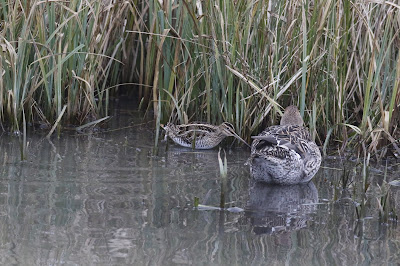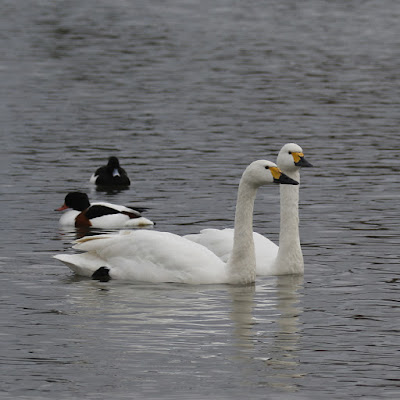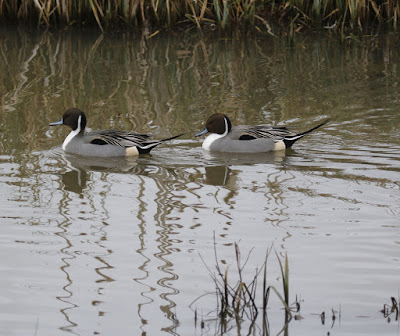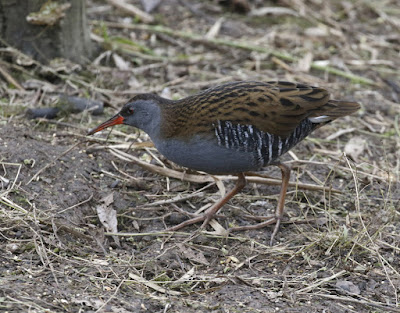It goes back a fair way to when I was just eighteen and training as a BTO (British Trust for Ornithology) ringer at Hersham Sewage Farm in Surrey. The farm is long gone but in those days it was an old fashioned farm with long filter beds, filled with reeds and sedge that provided an ideal winter habitat for Jack and Common Snipe and the highlight of any ringing session was to trap one or more Jack Snipe and have the pleasure of examining them in the hand and admire their beautiful plumage.They are not just streaked buff and brown, for their upperparts are subtly glossed iridescent green and purple, unlike the Common Snipe.
When I first met my now wife, I recounted to her, whilst having a drink in a pub how I was a bird ringer and described to her how wonderful a Jack Snipe looked in the hand. She expressed a desire to see one and emboldened by a few pints of beer I rather rashly said it would be no problem and we would go to Hersham and I would catch one so she could see it in the hand. Any bird ringer will tell you it is not that easy to catch a Jack Snipe but love's young dream drove me on.
The day arrived and I collected the light of my life from her home, she attired in a fur coat no less and me in a Triumph Sports Car (those were the days!) and off we went to Hersham one Saturday afternoon. I was now having serious doubts about my rash claim, all to impress the girl of my dreams but with the optimism of youth and passion I put up a net across one of the beds and walked up to the net and a Jack Snipe duly obliged and flew into the net!
The rest is history and we have now been married for over thirty years. So I am sure you can appreciate my fondness for Jack Snipes!
The origin of the name is thought to be from the small size of the bird as compared to the larger Common Snipe. For instance the smallest ball used in bowls is called 'a jack' and fishermen will refer to small pike as 'jack pikes.' If we wish to get a bit more academic the scientific binomen is Lymnocryptes minimus. Lymnocryptes comes from the Ancient Greek word limne meaning 'marsh' and kruptos meaning 'hidden.' Minimus is from Latin meaning 'smallest.'
When I first met my now wife, I recounted to her, whilst having a drink in a pub how I was a bird ringer and described to her how wonderful a Jack Snipe looked in the hand. She expressed a desire to see one and emboldened by a few pints of beer I rather rashly said it would be no problem and we would go to Hersham and I would catch one so she could see it in the hand. Any bird ringer will tell you it is not that easy to catch a Jack Snipe but love's young dream drove me on.
The day arrived and I collected the light of my life from her home, she attired in a fur coat no less and me in a Triumph Sports Car (those were the days!) and off we went to Hersham one Saturday afternoon. I was now having serious doubts about my rash claim, all to impress the girl of my dreams but with the optimism of youth and passion I put up a net across one of the beds and walked up to the net and a Jack Snipe duly obliged and flew into the net!
The rest is history and we have now been married for over thirty years. So I am sure you can appreciate my fondness for Jack Snipes!
The origin of the name is thought to be from the small size of the bird as compared to the larger Common Snipe. For instance the smallest ball used in bowls is called 'a jack' and fishermen will refer to small pike as 'jack pikes.' If we wish to get a bit more academic the scientific binomen is Lymnocryptes minimus. Lymnocryptes comes from the Ancient Greek word limne meaning 'marsh' and kruptos meaning 'hidden.' Minimus is from Latin meaning 'smallest.'
Jack Snipe are a long distance migrant and many come to winter in Britain from their breeding areas in northern Europe, Scandinavia and northern Russia. Others migrate to spend their winter on the Atlantic coasts of Europe and the Mediterranean. Some have been found to originate from north of Moscow or in Finnish Lapland and winter as far away as Zambia or northern Cameroon in the heart of Africa, whilst others hatched in eastern Siberia migrate to southeastern China or southern India. Extreme vagrants have even been found in the New World; four times in the USA and once in Labrador.
A hint of the origins of the Jack Snipe at Hersham Sewage Farm came when I retrapped a bird that had been ringed in Norway.
The world population in 2003 was estimated to be above one million individuals and it is considered to be currently unthreatened
The Jack Snipe in winter leads a hidden and solitary existence. Its cryptic plumage perfectly mimics its environment and allows it to hide successfully from most predators and remain invisible even to less than a metre away. So confident are they of their supreme camouflage they will crouch immobile when they are clearly visible in unsuitable terrain or out in the open.
Unlike Common Snipe the Jack Snipe, when flushed, does not rise at some distance and career off into the sky like a missile with a harsh cry but rises almost in a whisper of wings from right under your feet, diffident and silent and drops down almost immediately only a short distance away.
Being mainly nocturnal and secretive they are hard to observe in the open during daytime so an exceptional individual that has been, on occasions, observable during the daylight hours from a hide at Slimbridge WWT (Wildfowl and Wetlands Trust), during the last week, had me preparing a trip to renew an acquaintance which would be both a delight and revive many happy memories.
The first day I could manage to get away was Saturday, not the ideal day to visit such a popular venue as Slimbridge but I had no choice. The prospect of sitting in a hide, something I do not like due to the inevitable noise, distraction and disturbance from the other occupants was not appealing but there was no choice if I wished to see the bird. The prospect of seeing a Jack Snipe and a lot of other good birds as well, overcame any reservations on that score.
Being a member of WWT I can get into the hides before they officially open at 9.30am so I entered the grounds via the member's side gate and made my way to the Martin Smith Hide to join just three other birders looking out onto an area of water, mud, reeds and grass but there was no sign of the Jack Snipe.
 |
| My view from the Hide.The Jack Snipe frequented the small patch of triangular green just right of centre. The Tack Piece is the grass area beyond the fence line |
 |
| Common Snipe |
That was all I saw of it for some time before it re emerged at the further side of the scrape, still well hidden and went to sleep next to a female Mallard. By now it was past nine am and the hide began to fill up dramatically and become ever noisier. Everyone wanted to see the Jack Snipe but as it was virtually invisible it took lots of laboured directions from anyone who was currently watching it to get new arrivals in the hide to see it. Fair enough but the noise from all the chatter was incredible. Someone shouted to someone else from one end of the hide to the other as if they were in the street. I sat and tried to phase out the annoyance of noise and disturbance.There was nothing else I could do.
With the Jack Snipe only just visible the hide was full to bursting as everyone was waiting to see if it would move and they could get a better view of it but the Jack Snipe remained asleep amongst the grass and reeds. Occasionally it would commence that curious bouncing movement they employ when feeding but remained rooted to the spot still bobbing up and down, and then it would stop and resume its slumbers. It looked like this was going to be an attritional wait of some hours.
There is however only so long one can look at parts of a persistently immobile Jack Snipe and remain interested so I diverted my attention to admire the other birdlife, mainly ducks, frequenting the marshy scrape.The light was truly awful for photography but still the splendid colours of the male ducks were irrepressible, even in the dull light.
Eurasian Wigeon, that most sociable of ducks were feeding very close to the hide, on the grass bank that came right up to the hide's wooden front, plucking at the grass in small tight groups.
The males are at their very best at this time of year, their heads a deep rich chestnut with a creamy yellow blaze on their forehead and a breast the softest shade of pastel pink.The females are much dowdier, brown and grizzled grey on their heads and bodies but the adult females show a plumbeous pink tone to otherwise brown flanks that the younger females lack.
Eurasian Wigeon are a plump duck with a pleasingly curvaceous profile, their steep foreheads and rounded head imparting a gentle aura. Beyond the scrape on the large area of grassland and flashes of water called The Tack Piece hundreds more were also feeding, an animated carpet of grey, swarming in close formation across the wet grass.
 |
| Eurasian Wigeon |
 |
| Female Eurasian Wigeon |
Many other birds were also out there, sharing the flat expanse of grass. A huge scattered flock of Lapwings were present and periodically they and the wigeon would rise in alarm and circle in the sky, possibly troubled by the local Peregrine passing over. As the alarm ceased the Lapwings would drift on the wind, slowly sinking lower, wheeling in a loose formation into the wind with reedy cries, to settle back on the ground along with the wigeon.
I looked through my scope, scanning across The Tack Piece and found other species such as Curlew, Ruff, Golden Plover and Dunlin. Beyond were a number of Bewick's Swans congregated by a long narrow ditch of waterlogged grass. They are very much an iconic species at Slimbridge and much work has been done on their ecology and it was good to see numbers of this most appealing of swans
Other Bewick's Swans flighted in to join them, calling with a soft bugling to those on the ground, their all white plumage still retaining a purity in the grey conditions, as they flew with some grace to join the small gathering of fellow swans out on The Tack Piece.
 |
| Bewick's Swans |
 |
| Bewick's Swans |
 |
| Northern Pintails |
 |
| Male Eurasian Teal |
 |
| Northern Shoveler |
 |
| Lapwing |
 |
| Water Rail and Eurasian Teal |
I returned to the Martin Smith Hide to find in my absence that the Jack Snipe had moved, just as I hoped it would, but perversely not to a more open situation but exactly the opposite. It was now virtually invisible but one brave gent with a telescope was desperately trying to assist members of the public to see whatever miniscule part of the Jack Snipe remained visible. Each time he repeated the words ' If you look in my scope, you should see a reed that is bent over. Look at the top of that and just beyond and you can see its eye!'
This was repeated ad nauseam as a succession of people not unreasonably failed to see the Jack Snipe through his scope. He meant well but it inevitably became tedious and annoying as he repeated his mantra over and over to each new visitor to the hide.
He was finally reduced to silence as the Jack Snipe moved. It was approaching 2pm. The Jack Snipe, disturbed by a Moorhen, commenced its curious bouncing up and down on flexed legs which is often but not invariably a sign that it intends to start feeding. Incidentally for those who are wondering as to the reason it bobs like a small toy, it is so its monocular vision can act in a binocular fashion, allowing it to judge distance and depth of field.
It was currently at the back of the grassy scrape but slowly commenced working its way forward along the muddy margin of the scrape but was forever and frustratingly obscured by blades of grass or spikes of sedge and cut reed. There were just a couple of tiny areas of open mud without any vegetation right opposite my position in the hide and I willed the Jack Snipe to progress as far as them. Slowly it 'pogo'd' its way towards the front edge of the scrape. I held my breath but it diverted off into the grass. I gave an involuntary sigh of disappointment but to my relief it came back to the water's edge and at last showed itself, almost perfectly as it gently bounced along, probing its bill into the soft mud as it progressed.
It was currently at the back of the grassy scrape but slowly commenced working its way forward along the muddy margin of the scrape but was forever and frustratingly obscured by blades of grass or spikes of sedge and cut reed. There were just a couple of tiny areas of open mud without any vegetation right opposite my position in the hide and I willed the Jack Snipe to progress as far as them. Slowly it 'pogo'd' its way towards the front edge of the scrape. I held my breath but it diverted off into the grass. I gave an involuntary sigh of disappointment but to my relief it came back to the water's edge and at last showed itself, almost perfectly as it gently bounced along, probing its bill into the soft mud as it progressed.
 |
| Jack Snipe |
 |
| Drake Mallard and no Jack Snipe |
 |
| Drake Mallard and Jack Snipe! |





































No comments:
Post a Comment